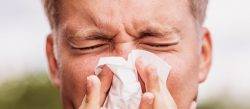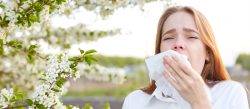Kids and allergies
Why do children develop allergies? Children with allergies have an immune system that is overactive. It has at some stage mistakenly…
Read MorePublished on May 23, 2022

Allergy symptoms occur when your body’s immune system overreacts to something that is usually harmless for most people, typically known as an allergen. Whenever an allergen is breathed in or comes into contact with the skin, your immune system attacks the substance by releasing chemicals such as histamine.
People affected by allergens may experience symptoms such as sneezing, runny nose, stuffy nose, watery eyes, itchy skin or swelling related to allergy.
Several factors appear to increase the risk of developing allergic disorders. These can include :
Having a family history of allergies in a parent or sibling can increase your risk of developing allergies.
Introducing your baby to cow’s milk, soy milk formula or solid foods before three to four months of age can be a risk factor.
Being born in spring-time. Babies born during this time of the year have a higher risk of developing seasonal allergic rhinitis or hayfever.
Passive exposure to cigarette smoke also increases a child’s risk of developing allergic respiratory symptoms.
Although allergies are more common in children, they can develop at any time or age.
Not always. Sometimes allergy symptoms start in childhood, disappear for many years, and then start up again in adult life. Unfortunately, allergic people are also prone to developing new allergies.
Allergies can usually be treated through a range of products including, antihistamines, which stop histamine from attaching to cells and causing allergy symptoms.
Telfast® is a fast, non-drowsy oral antihistamine that works to reduce the symptoms of hayfever allergies. If you suffer from hayfever allergies, click here to find a Telfast® product appropriate for you.
For more information, visit the ASCIA website.
Always read the label. Follow the directions for use. If symptoms persist, talk to your health professional.
Dust mites are tiny creatures that are too small to be seen with the naked eye. They reside in fibre-filled surfaces such as mattresses, pillows, linen, carpets and other areas where the conditions are warm, dark and humid. An allergic reaction can be triggered by inhalation of the mites’ shed skins and their waste.
Pet allergies are often triggered by pet dander from animals such as dogs and cats. People with pet allergies have sensitive immune systems that react to usually harmless proteins found in dander, pet saliva or urine. Unfortunately for animal lovers, avoiding exposure to the problem animal is the best way to avoid allergy symptoms.
Mould is commonly found both indoors and outside and may be found in damp, poorly ventilated areas. This allergen can trigger symptoms such as sneezing, coughing and a blocked or runny nose. Kitchens, bathrooms and laundries are the most common areas of the house that mould grows because of condensation and a lack of airflow.
Many people are allergic to pollen produced by trees, grasses, weeds and flowers. This type of allergic reaction is known as hayfever. Symptoms can include sneezing, runny nose, stuffy nose, watery eyes, itchy skin or swelling.
Protein found in fruits and vegetables may cause oral allergy syndrome and causes itching in the mouth when a particular fruit or vegetable is eaten. In some people who suffer hayfever allergy symptoms, their immune system may treat proteins found in some fruits and vegetables the same way that it treats proteins found in pollen. The result is a condition called oral allergy syndrome.
Cooking distorts the proteins responsible for the allergic reaction, so the same foods that cause symptoms when eaten raw are often tolerated when cooked. Often the responsible proteins are in the skin.
Three common allergens found throughout the home are listed below, with tips on what you can do to reduce your exposure to them.
Always read the label. Follow the directions for use. If symptoms persist, talk to your health professional.
[i] HEPA filters are a “High-Efficiency Particulate Air” vacuum filter. HEPA vacuum filters capture small particles which may not be absorbed by regular filters, providing additional relief for those with allergies.
Learn about which Telfast product may be appropriate for you.
SEE THE PRODUCTS HEREMAT-AU-2102143. Nov 2021.

Why do children develop allergies? Children with allergies have an immune system that is overactive. It has at some stage mistakenly…
Read More
What are allergies? Allergies are caused by an overreaction of the immune system to a particular substance, known as an…
Read More
What are antihistamines? Antihistamines are used by allergy sufferers to relieve allergy symptoms from seasonal and year-round allergies. What types of…
Read MoreIf you’d like to know which product might be suitable for your needs, or if you have questions relating to any of our products, please fill in the form below. We’d love to hear from you. To speak with a team member or report an adverse event, please call 1800 818 806 within Australia.
Thank you for your submission. A representative will be in contact shortly.
Submit